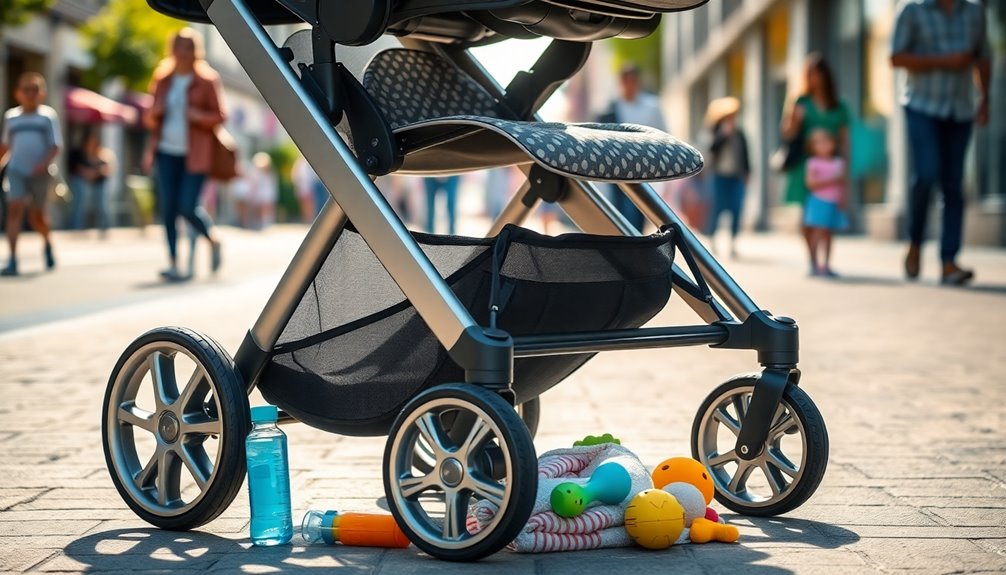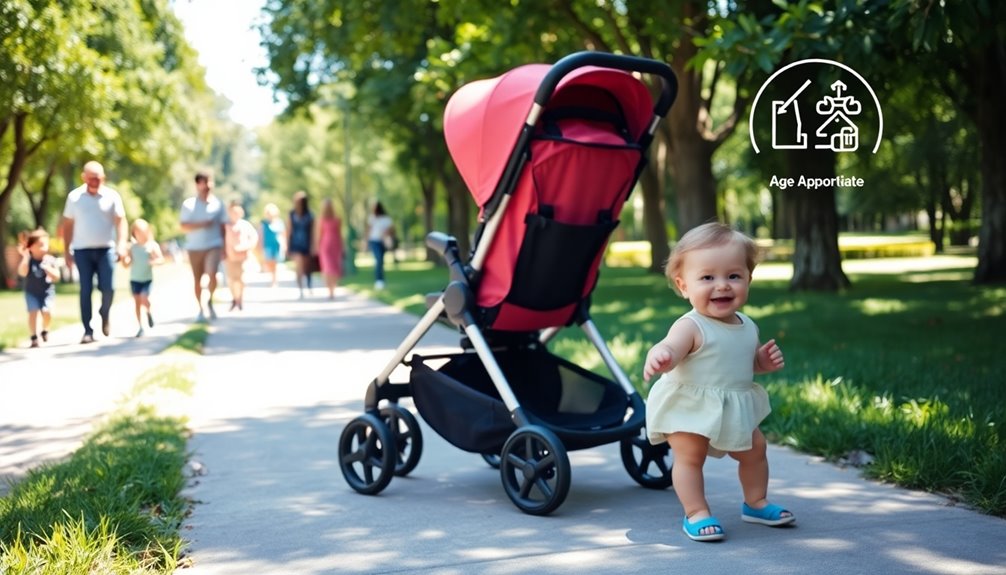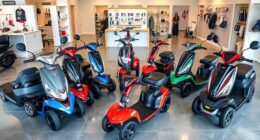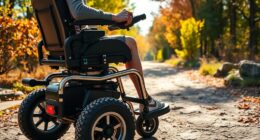When buying a stroller, you can't overlook critical factors like your child's age and weight. Stroller types vary, from lightweight umbrellas to robust full-sized options. Safety features, such as reliable brakes and a five-point harness, are essential. Don't forget about your budget—strollers can range greatly in price. Testing the stroller in-store is a must. There's so much more to evaluate before making your choice, so keep exploring to guarantee you make the right decision!
Key Takeaways
- Consider your child's age and weight to ensure the stroller meets safety and comfort requirements.
- Look for strollers with safety features like a five-point harness and reliable brakes to prevent accidents.
- Test maneuverability and folding mechanisms in-store for ease of use and convenience.
- Evaluate the durability and resale value of the stroller to make a long-term investment.
- Check for compatibility with infant car seats and adjustable features for your child's growth.
Key Factors to Weigh When Choosing a Stroller

When you're choosing a stroller, it's vital to take into account your child's age and weight first. For infants, look for strollers compatible with an infant car seat and featuring deep reclines.
As your child grows, adjustable features become necessary. Evaluate the stroller's lightweight design for ease of use and transport, especially if you're traversing urban settings.
Safety features are paramount; verify it has a sturdy frame, reliable brakes, and a secure five-point harness.
Don't forget about storage space; ample undercarriage storage can make outings easier.
Finally, test the stroller's maneuverability and folding mechanism in-store to confirm it adapts well to different terrains and folds easily, especially if you're considering a compact stroller or travel systems. Additionally, consider models with child-friendly features that enhance safety and comfort for your little one.
Understanding Different Types of Strollers

How do you choose the right stroller for your lifestyle? Start by considering the types available.
Full-sized strollers offer durability and storage baskets but can be bulky. If you need something lightweight, umbrella strollers are perfect for quick trips, though they might lack comfort.
Full-sized strollers provide durability and storage, while umbrella strollers are ideal for lightweight convenience on quick outings.
For active parents, jogging strollers provide a smooth ride on various terrains, but remember they're unsuitable for infants under six months.
Travel systems combine infant car seats with strollers for easy changes, though they tend to be heavier.
If you have two little ones, double strollers come in side-by-side or tandem options, accommodating your needs.
Always check the weight of the stroller and verify it meets safety standards before making your choice.
Importance of Age-Appropriate Design and Safety

When you choose a stroller, it's essential to take into account your baby's age and support needs.
Infants under six months need a fully reclined seat to protect their neck and spine, while older babies benefit from adjustable designs.
Prioritizing safety features like a sturdy frame and reliable brakes guarantees your little one stays secure during outings.
Infant Support Requirements
Choosing the right stroller for your infant isn't just about style; it's vital for their safety and comfort. For infants under 6 months, look for a stroller with a near-flat reclining position to verify proper spinal alignment, as they lack head and neck control.
Adjustable features are important for accommodating growth, allowing older babies to sit up or recline as needed. A sturdy frame made from durable materials provides stability, preventing tip-overs that can lead to stroller-related injuries.
Additionally, a five-point harness system is essential for securely restraining your little one, minimizing the risk of falls. Always check for safety certifications from organizations like the Juvenile Products Manufacturers Association to confirm the stroller meets rigorous safety standards.
Safety Feature Evaluation
Guaranteeing your stroller is designed with safety features tailored to your child's age is key to providing a secure experience.
For infants, look for a stroller with a durable frame that offers stability and a near-flat recline position, promoting safe breathing and proper spinal alignment. A reliable restraint system, ideally a five-point harness, will keep your baby secure and minimize the risk of falls.
Don't overlook the importance of reliable brakes, preferably foot-activated, to prevent the stroller from rolling away when parked.
Finally, always check for safety certifications, such as those from the Juvenile Products Manufacturers Association (JPMA), to guarantee the stroller meets established safety standards.
Your child's safety is paramount, so prioritize these features when making your selection.
Evaluating Essential Safety Features

When choosing a stroller, it's essential to evaluate its safety features closely.
Make sure it has a reliable brake system, a secure harness mechanism, and a sturdy frame construction to keep your child safe and stable.
These elements can make a significant difference in your stroller's performance and your child's safety.
Reliable Brake Systems
A reliable brake system is one of the top safety features to evaluate when buying a stroller. Prioritize foot-activated brake systems for secure engagement and ease of use.
Look for a dual-braking system that locks both rear wheels, preventing any unintended movement. High-quality strollers often have brakes that are easy to engage and disengage, allowing you to secure the stroller quickly while holding your child.
Accessible brakes should be intuitive; complicated systems can pose safety risks during operation. Additionally, always verify that the stroller meets safety certifications, like those from the JPMA, which guarantee rigorous testing of braking mechanisms.
Investing in a stroller with a reliable brake system is essential for peak stroller safety.
Secure Harness Mechanisms
Choosing a stroller with a secure harness mechanism is essential for your child's safety. Look for a five-point harness that keeps your little one snug and reduces the risk of falls or injuries during use.
An adjustable harness is crucial, accommodating your growing child and ensuring a secure fit at every stage. Check for harness systems that are user-friendly for parents but challenging for toddlers to unbuckle, striking the right balance between safety and convenience.
Don't forget to verify safety certifications from the Juvenile Products Manufacturers Association, confirming rigorous testing for effectiveness.
Finally, opt for harness straps made from durable materials that are easy to clean, promoting hygiene and enhancing child comfort throughout your stroller adventures.
Sturdy Frame Construction
Safety starts with a sturdy frame construction, as it plays an essential role in your stroller's stability. A well-built frame not only prevents tipping but also guarantees a secure environment for your baby, especially on uneven surfaces.
When evaluating strollers, keep these key features in mind:
- Made from high-quality materials like aluminum or reinforced plastics
- A reliable braking system, preferably foot-activated
- Safety certifications, such as those from JPMA
- An appropriate weight limit to support your child and storage compartments
- Durability to withstand daily use and ease of transport
Investing in a stroller with these features will give you peace of mind, knowing your little one is safe and secure on every outing.
Setting a Realistic Budget for Your Purchase

When you're preparing to buy a stroller, setting a realistic budget is vital to guarantee you get the best value for your investment. Stroller prices can vary dramatically, from $30 for basic models to over $1,500 for premium options.
When setting a budget, consider not just the initial cost but also potential expenses for accessories, which can add $50 to $200. High-quality strollers often last for years and can serve multiple children, making them a smart investment.
Additionally, think about resale value; many high-end models retain significant worth, allowing you to recover some costs later. Balancing quality and affordability while ensuring the stroller meets your family's needs and lifestyle is fundamental for a successful purchase.
The Value of Test-Driving Strollers Before Buying

How can you be sure the stroller you're evaluating will truly meet your needs? Test-driving strollers is essential to assess comfort and maneuverability.
You'll want to see how it feels with your child seated inside. Here are key aspects to reflect on during your test drive:
- Folding mechanism: Can you collapse it easily with one hand?
- Safety: Do the brakes function reliably and engage smoothly?
- Storage basket: Is it accessible and large enough for your essentials?
- Weight: Does it feel manageable while steering?
- Features: Are the functionalities suited to your lifestyle?
Frequently Asked Questions
What to Check Before Buying a Stroller?
Before buying a stroller, you should check its weight and size, especially if you need something lightweight for quick trips.
Look for safety features like a five-point harness and sturdy brakes. Test how easily it maneuvers on different terrains and assess the quality of the wheels.
Don't forget to evaluate foldability and storage options.
Finally, make sure it's suitable for your child's age, accommodating newborns with reclining seats or car seat compatibility.
When Choosing a Stroller, a Few Features Can Be Considered.?
You might think all strollers are the same, but they really aren't. When choosing a stroller, consider weight and foldability for easy transport.
Safety features, like a five-point harness and sturdy brakes, are vital for your child's protection.
Don't forget storage capacity to carry essentials, and check compatibility with infant car seats for smooth changes.
Finally, test maneuverability on different terrains to guarantee it fits your family's lifestyle perfectly.
What Are Common Stroller Problems?
Common stroller problems include difficulty in maneuverability, especially with heavier models or those with small wheels that struggle over curbs.
You might also find inadequate storage, making it hard to carry essentials during outings.
Complicated folding mechanisms can be frustrating when you need to store or transport the stroller quickly.
Additionally, safety concerns often arise from poorly designed harness systems, and wear on wheels can decrease performance over time.
How Do You Know What Kind of Stroller You Need?
To know what kind of stroller you need, assess your lifestyle first. If you're always on the go, a lightweight stroller might suit you best.
For active outings, consider a jogging stroller. Think about your child's age, too; newborns often need deeper reclining options.
If you're planning for more kids, look into double strollers.
Finally, don't forget to test drive different models in-store to find one that feels right for you.
Conclusion
In the end, choosing the right stroller is like finding the perfect dance partner—it's all about balance and compatibility. By considering factors like safety, age-appropriateness, and your budget, you can glide through the selection process with ease. Don't forget to test-drive a few options to see which one feels just right. With a bit of thought and exploration, you'll be ready to roll into parenthood with confidence and style!









